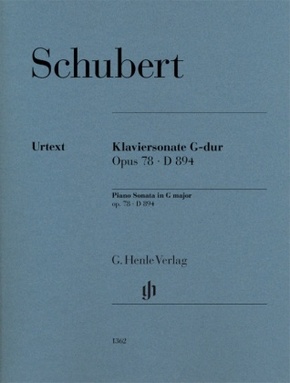Franz Schubert - Klaviersonate G-dur op. 78 D 894 - Besetzung: Klavier zu zwei Händen
| Verlag | Henle |
| Auflage | 2021 |
| Seiten | 35 |
| Format | 21,2 x 0,4 x 30,9 cm |
| Gewicht | 174 g |
| Reihe | G. Henle Urtext-Ausgabe |
| ISBN-13 | 9790201813622 |
| Bestell-Nr | 91131927BA |
Die große und technisch anspruchsvolle G-dur-Sonate entstand zwei Jahre vor Schuberts Tod im Oktober 1826 und gehört zu den nur drei Klaviersonaten, die noch zu seinen Lebzeiten im Druck erschienen. Der ungewöhnliche Titel der Erstausgabe "Fantasie, Andante, Menuetto und Allegretto" stammt vom Verleger Haslinger und verdankt sich wohl der träumerisch-melancholischen Grundstimmung des 1. Satzes, der den traditionellen Vorstellungen eines Sonatenkopfsatzes wenig entsprach. Kaum verwunderlich, dass "Fantasie-Sonate", wie sie noch heute oft genannt wird, mit ihrer freien und romantischen Art später Künstler wie Franz Liszt oder Robert Schumann begeisterte, der sie als vollendet "in Form und Geist" bezeichnete. Die vorliegende Urtextausgabe unterzieht alle bekannten Quellen, darunter das Autograph in der British Library, einer gründlichen Neuuntersuchung und präsentiert sich im gewohnt brillanten Henle-Notenstich. Das Vorwort der Schubert-Expertin Andrea Lindmayr-Brandl und der detaill ierte Bemerkungsteil geben ausführlich Auskunft zur Werkentstehung, zu den Quellen und ihren Lesarten. Ein weiteres Highlight ist der Fingersatz des Pianisten Martin Helmchen.
Inhaltsverzeichnis:
Klaviersonate G-dur op. 78 D 894
The large and technically demanding G major Sonata was composed two years before Schubert's death in October 1826 and is one of only three piano sonatas that appeared in print during his lifetime. The unusual title of the first edition "Fantasie, Andante, Menuetto und Allegretto" stems from the publisher Haslinger and is probably due to the dreamy-melancholy underlying mood of the first movement which corresponded little to the traditional concepts of a sonata's first movement. It is hardly surprising that the "Fantasy-Sonata", as it is often still called today, later inspired artists such as Franz Liszt and Robert Schumann with its free and romantic nature, who described it as being consummate "in form and spirit". For the present Urtext edition a thorough re-examination of all known sources was undertaken, including the autograph in the British Library, and the edition now presents itself with the usual crystal clear Henle music engraving. The preface by Schubert expert Andrea L indmayr-Brandl and the detailed commentary section provide comprehensive information about the genesis of the work, the sources and their readings. A further highlight are the fingerings by pianist Martin Helmchen.

